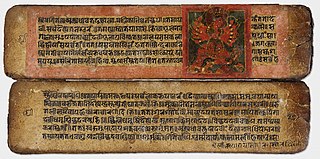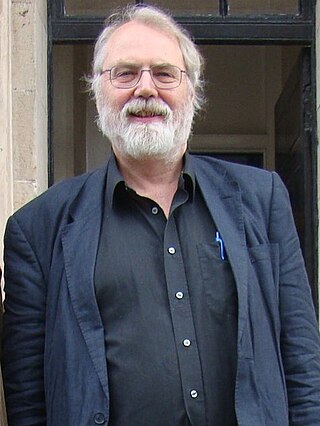
Sanskrit is a classical language belonging to the Indo-Aryan branch of the Indo-European languages. It arose in South Asia after its predecessor languages had diffused there from the northwest in the late Bronze Age. Sanskrit is the sacred language of Hinduism, the language of classical Hindu philosophy, and of historical texts of Buddhism and Jainism. It was a link language in ancient and medieval South Asia, and upon transmission of Hindu and Buddhist culture to Southeast Asia, East Asia and Central Asia in the early medieval era, it became a language of religion and high culture, and of the political elites in some of these regions. As a result, Sanskrit had a lasting effect on the languages of South Asia, Southeast Asia and East Asia, especially in their formal and learned vocabularies.

Sanskrit literature broadly comprises all literature in the Sanskrit language. This includes texts composed in the earliest attested descendant of the Proto-Indo-Aryan language known as Vedic Sanskrit, texts in Classical Sanskrit as well as some mixed and non-standard forms of Sanskrit. Literature in the older language begins with the composition of the Ṛg·veda between about 1500 and 1000 BCE, followed by other Vedic works right up to the time of the grammarian Pāṇini around 6th or 4th century BCE.
Indology, also known as South Asian studies, is the academic study of the history and cultures, languages, and literature of the Indian subcontinent, and as such is a subset of Asian studies.

The Smartatradition, also called Smartism, is a movement in Hinduism that developed and expanded with the Puranas genre of literature. It reflects a synthesis of four philosophical strands, namely Uttara Mīmāṃsā, Advaita, Yoga, and theism. The Smarta tradition rejects theistic sectarianism, and is notable for the domestic worship of five shrines with five deities, all treated as equal – Ganesha, Shiva, Shakti, Vishnu and Surya. The Smarta tradition contrasted with the older Shrauta tradition, which was based on elaborate rituals and rites. There has been a considerable overlap in the ideas and practices of the Smarta tradition with other significant historic movements within Hinduism, namely Shaivism, Brahmanism, Vaishnavism, and Shaktism.

Professor Johann Georg Bühler was a German scholar of ancient Indian languages and law.

Moriz Winternitz was a scholar from Austria who began his Indology contributions working with Max Müller at the Oxford University. An eminent Sanskrit scholar, he worked as a professor in Prague in the German part of Charles-Ferdinand University after 1902, for nearly thirty years. His Geschichte der indischen Literatur, published 1908–1922, offered a comprehensive literary history of Sanskrit texts. The contributions on a wide range of Sanskrit texts by Winternitz have been an influential resource for modern era studies on Hinduism, Buddhism and Jainism.
Paul Thieme was a German Indologist and scholar of Vedic Sanskrit. In 1988 he was awarded the Kyoto Prize in Arts and Philosophy for "he added immensely to our knowledge of Vedic and other classical Indian literature and provided a solid foundation to the study of the history of Indian thought".
In Indian aesthetics, a rasa literally means "juice, essence or taste". It is a concept in Indian arts denoting the aesthetic flavour of any visual, literary or musical work that evokes an emotion or feeling in the reader or audience, but cannot be described. It refers to the emotional flavors/essence crafted into the work by the writer or a performer and relished by a 'sensitive spectator' or sahṛidaya, literally one who "has heart", and can connect to the work with emotion, without dryness.

The Clay Sanskrit Library is a series of books published by New York University Press and the JJC Foundation. Each work features the text in its original language on the left-hand page, with its English translation on the right. The series was inspired by the Loeb Classical Library, and its volumes are bound in teal cloth.
Bhaṭṭikāvya is a Sanskrit-language poem dating from the 7th century CE, in the formal genre of the "great poem" (mahākāvya). It focuses on two deeply rooted Sanskrit traditions, the Ramayana and Panini's grammar, while incorporating numerous other traditions, in a rich mix of science and art, poetically retelling the adventures of Rama and a compendium of examples of grammar and rhetoric. As literature, it is often considered to withstand comparison with the best of Sanskrit poetry.

Paul Dundas was a British Indologist, an honorary fellow in Sanskrit language and Head of Asian studies at the University of Edinburgh. His teachings and research focused extensively on understanding Jainism, Buddhism, Sanskrit literature and Middle Indo-Aryan philology. He was regarded as one of the leading scholars in Jaina and Prakrit studies. He was a member of the Council of the Pali Text Society.
Rohan Narayana Murty is a junior fellow at the Harvard Society of Fellows, founder of the Murty Classical Library of India and founder and chief technical officer of the digital transformation company Soroco, which specialises in automation using artificial intelligence sources.
The Murty Classical Library of India began publishing classics of Indian literature in January 2015. The books, which are in dual-language format with the original language and English facing, are published by Harvard University Press. The library was established through a $5.2 million gift from Rohan Murty, the son of Infosys co-founder N. R. Narayana Murthy and social worker and author Sudha Murty. The series will include translations from Bengali, Gujarati, Hindi, Kannada, Marathi, Punjabi, Sanskrit, Tamil, Telugu, Urdu, other Indian languages and Persian. It will include fiction, poetry, nonfiction, and religious texts from all Indian traditions including Buddhism and Islam. The projected 500 volumes, to be published over a century, have a corpus of thousands of volumes of classic Indian literature to draw on.
Ludo Rocher (1926–2016) was an eminent Sanskrit scholar, and the W. Norman Brown Professor Emeritus of South Asia Studies at the University of Pennsylvania.

The Battle for Sanskrit: Is Sanskrit Political or Sacred, Oppressive or Liberating, Dead or Alive? is a 2016 book written by Rajiv Malhotra which criticizes the academic discipline of Indology, as practiced by Western scholars and particularly Sheldon Pollock.
Political philology is "an active mode of understanding" texts. It does not simply take (religious) texts at face-value as religious texts without any connection to a social and political context, but situates them in a historical context, and is sensitive to the social and political implications and usages of a (religious) text.

Krishnacharya Tamanacharya Pandurangi, also known by the pen name Viswamangala, was an Indian Sanskrit scholar and a notable Indologist. Pandurangi was unique among contemporary Sanskrit scholars, being simultaneously at home among both traditional and modern systems of education. In 1989, the Government of India honoured him with the Rashtrapati Award for his contributions to literature and research.
Śāntarasa is considered as a ninth rasa, a concept of aesthetic flavour in Sanskrit literature. According to translation of Abhinavabhārati, Abhinavagupta's commentary on Nāṭyaśāstra by some experts, śāntarasa may be defined as: "that which brings happiness and welfare to all beings and which is accompanied by the stabilization in the Self". It has as its stable emotion (sthāyibhāva) as impassivity which culminates in detachment (Vairāgya) arising from knowledge of truth and purity of mind. According to J L Masson and M V Patwardhan, who have collected the original manuscripts and translated Abhinavagupta's work, observe: the audience undergoes transcendental experience, which is basic to all aesthetic experience in a play based on śāntarasa. It was not included in the list of rasas mentioned by Bharata in his epic Nāṭyaśāstra. The inclusion of this rasa as a prominent one in Sanskrit poetry and dramaturgy is attributed to Udbhata, a president in the court of king Jayapida of Kashmir during 779-813 AD and a contemporary of Vamana. Much of the literary criticism on this flavor was further carried out by Ānandavardhana in his commentary on Mahābhārata and Rāmāyaṇa and later by Abhinavagupta in Nāṭyaśāstra.
Audrey Truschke is a historian of South Asia and an associate professor at Rutgers University. Her work focuses on inter-community relations in medieval South Asia, especially during the Mughal Empire. In 2017, she was conferred with the John F. Richards Prize in South Asian History by American Historical Association.

Vaishnavism in Tamil Nadu finds its earliest literary mention in ancient Tamil Sangam literature from the 5th century BCE. Maha Vishnu or Perumal is considered to be the most mentioned god in Sangam Literature. Some of the earliest known mentions of Perumal, and the Tamil devotional poems ascribed to him, are found in Paripāṭal – the Sangam era poetic anthology. He is a popular Hindu deity, particularly among Tamils in Tamil Nadu and the Tamil diaspora, as well as in Vaishnava temples. One of the richest and largest Hindu temples complexes is dedicated to Perumal in South India. [where? citation needed]











